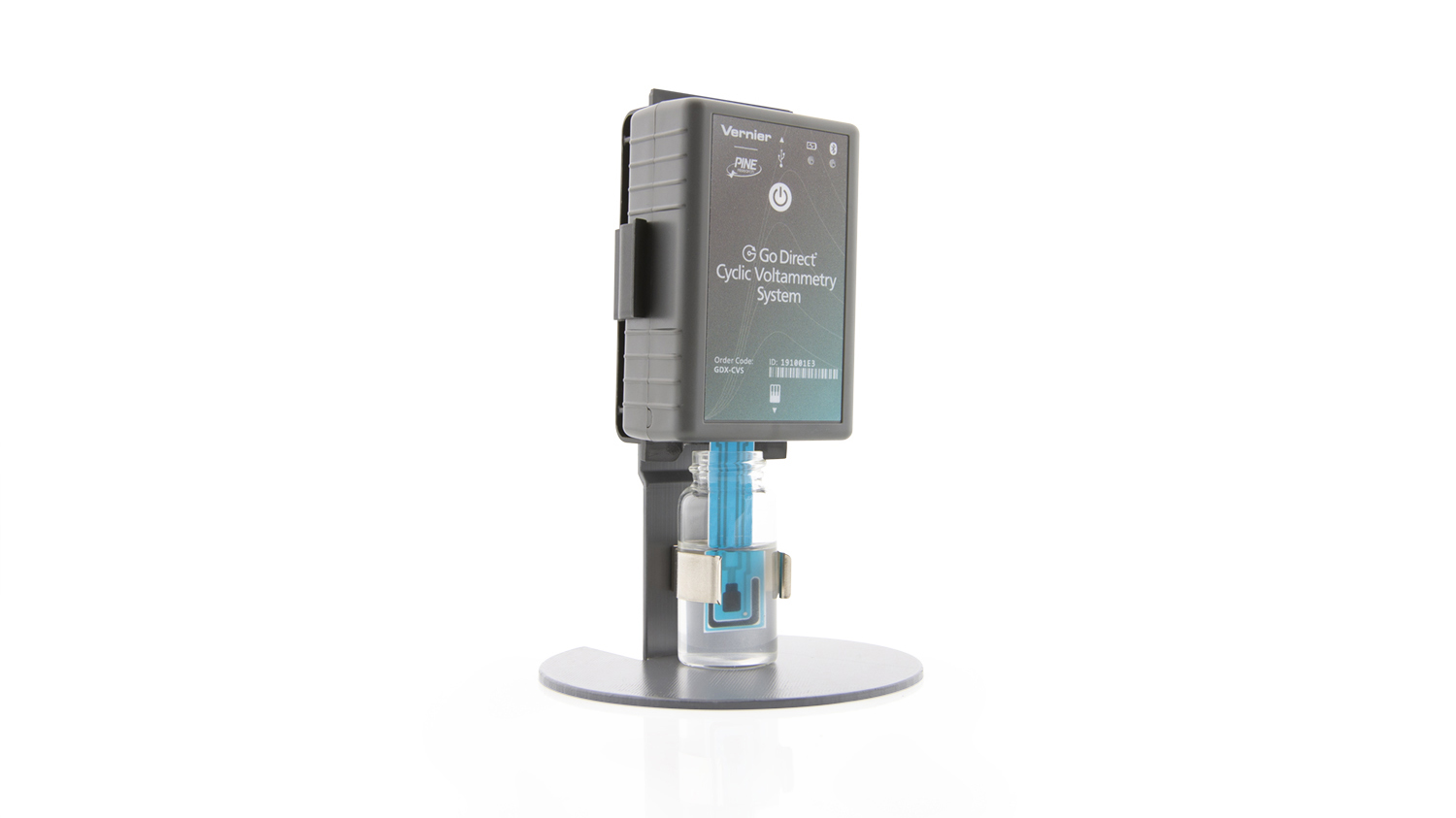Go Direct® Cyclic Voltammetry System (GDX-CVS )

Troubleshooting
Primary Test
- Connect your sensor as described in the Getting Started instructions for your device.
- Insert a screen-printed electrode (SPE) into the SPE connector on the Cyclic Voltammetry System.
- Fill the scintillation vial about halfway full (~10 mL) with a 1.0 mM solution of acetaminophen in contact lens solution. Insert the scintillation vial into the clip on the stand.
- Carefully guide the Cyclic Voltammetry System with SPE attached downward into the vial and snap the instrument into place.
- The default data collection parameters are appropriate for this experiment.
⚬ If using Instrumental Analysis, click or tap Apply to dismiss the Voltammetry settings box. - Click or tap Collect to begin data collection. It will stop automatically. You should see a duck-shaped voltammogram.
SPE Cleaning—You may want to clean the SPE prior to an experiment to activate the carbon surface. Instructions for how to do so are in the user manual.
Additional Troubleshooting
- Does Vernier offer a sensor to test for lead in water?
- Can I get a platinum electrode for the Cyclic Voltammetry System?
- The SPE doesn't fit straight in my GDX-CVS.
- Screen-Printed Electrodes (SPE) Troubleshooting and FAQs
- Go Direct sensor does not connect to LabQuest 2 via Bluetooth.
- Troubleshooting Bluetooth Connections with Go Direct Sensors
- What can I do if a Go Direct sensor's Bluetooth LED flashes red and green when I try to connect to it and the connection fails?
- Will my device work with Go Direct Sensors via Bluetooth?
- How do I know if my LabQuest will work with Go Direct Sensors and Go Wireless devices?
Specifications
- Data Collection Modes
⚬ Cyclic Voltammetry
⚬ Bulk Electrolysis
⚬ Open Circuit Potential - Potential Range
⚬ Operational range: –2000 to +2000 mV
⚬ Practical range*: –1200 to +1200 mV - Current Ranges
⚬ High (± 1000 μA)
⚬ Medium (± 100 μA)
⚬ Low (± 10 μA)
⚬ Lowest (± 1 μA) - Power: Internal rechargeable battery or USB connection
- Sampling Rates
⚬ Cyclic Voltammetry
▸Minimum Sweep Rate: 1 mV/s
▸Maximum Sweep Rate: 2000 mV/s
▸Recommended Maximum Sweep Span: 1600 mV
▸Available Number of Sweep Segments: 1, 2, or 3
⚬ Bulk Electrolysis
▸Minimum Sampling Rate: 2 samples per second
▸Maximum Sampling Rate: 200 samples per second
⚬ Open Circuit Potential
▸Minimum Sampling Rate: 2 samples per second
▸Maximum Sampling Rate: 200 samples per second - Dimensions: 9 cm length, 6 cm width, 3 cm depth
- Connections:
⚬ Wireless: Bluetooth® v4.2 (wireless range 30 m unobstructed)
⚬ Wired: USB 2.0 full speed
* The Practical Range limit applies when using Vernier screen-printed electrodes in aqueous solutions. Results may vary when using other electrodes and solvents.
Calibration
Calibrate? No. The sensor is custom calibrated prior to shipping. The user cannot calibrate the system.
Related Products
- Micro USB to USB-C Cable (
CB-USB-C-MICRO ) - Go Direct® Charge Station (
GDX-CRG ) - Go Direct® ORP Sensor (
GDX-ORP ) - Go Direct® Constant Current System (
GDX-CCS )
Replacement Parts
- Micro USB Cable (
CB-USB-MICRO ) - Screen-Printed Electrodes (SPE)
⚬ CVS-SPE25: package of 25
⚬ CVS-SPE100: package of 100
